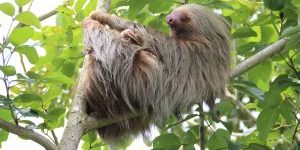The first time someone described a Sloth was by the naturalists in the 1700s, and the Sloths were misunderstood. The early scientists designated them as slow-moving beasts, lazy and useless, and believed to be species that were unlikely to survive due to its imperfections. In modern times, sloths have undergone an image makeover and are now touted across the internet as the most loveable creatures in the universe.
Both standings fail to give a full picture of this amazing animal. Here are some little-known sloth realities to help you make your own criteria.
1) Sloths are some of the most common mammals of the rainforest
Though spotting a wild sloth can be a challenge (they live in trees after all), sloths are between the best-adapted creatures in the rainforest. The mammals spend almost their entire lives in trees, which gives them protection from their natural predators, and biologists estimate that sloths make up more than half the total biomass of rainforests in Central and South America. Of the six known species of sloths, only two are considered endangered the maned sloth (Bradypus torquatus) from Brazil and the Pygmy sloth (Bradypus pygmies), which only lives on one small island off the coast of Panama.

2) Sloths are sort of gross
They may have cute, piggy, melting heart faces, but wild sloths aren’t the kind of animals you would want to cuddle up with at night. A sloth’s fur serves as a self-contained ecological community supporting groups of moths and algae. Along with helping sloths mix in with the foliage, the mammal’s personal algae gardens also serve as a nutrition source. True fact, sloths eat algae that grow out of their own fur. Nastier still, investigators now believe that sloths sustain these mini-ecosystems by fertilizing them with their own feces. Talking about gross, right?
3) Sloths risk their lives to poop
Sloths have almost no reason to leave the safety of the rainforest canopy, but once a week the sluggish Sloths descend to the base of their favorite tree to defecate. The exact reason why sloths make this dangerous trip is still a mystery, but researchers believe that it may help maintain the algae gardens/grounds in their fur and helps fertilize the tree where they fed on.
4) Sloths can turn their heads almost all the way around
A sloth can turn its head 270 degrees, looking almost completely behind itself, imagine the possibilities!
5) Sloths spend 90 percent of their time upside down
Preparing wild sloths with backpacks that track their movements, an investigator in Costa Rica recently determined that sloths spend almost all their time inverted. To handle the pull of gravity, sloths have evolved special fibrous adhesions that keep their organs from shifting.
6) Sloths have predators
With the bugs, and the algae and the poop fertilizer, sloths may not sound very attractive, but jungle cats and large birds of prey will eat them if they get the chance. Despite their leisureliness, sloths can be surprisingly resilient to predators.
Check out how long this sloth archives to ward off a Puma in this video. If you’re nauseous, stop before 4:40 when the Puma finally wins the battle.
7) Sloths are great swimmers
They may be slow in the trees, but sloths move up to three times faster in the water.
8) Sloths’ metabolism is as slow as can be
It can take a sloth up to 30 days to digest just one leaf. To escape accidentally poisoning themselves, sloths never eat too many leaves from one tree.
9) The nasty fungus in sloth fur may cure cancer
Last year scientists took samples of the fungus from sloth hairs and found that some were adept at combat parasites, bacteria, and even breast cancer cells. The study’s researchers believe potential life-saving drugs could come out of the study. Click here for the link
10) Sloths don’t sleep all-day
Though captive sloths have been known to sleep 14 to 20 hours a day, wild sloths will usually only snooze for 10 hours, which is not a lot considering their nature. Cats, for example, sleep about 20 hours per day.
11) Sloths have a death grip, literally
With their long claws and sturdy muscles, sloths have a powerful grip. Their bodies are so conditioned to hanging from branches that deceased sloths have been found still suspended from the branch they were climbing on.
Source: http://www.ticotimes.net/2015/10/17/11-little-known-sloth-facts









